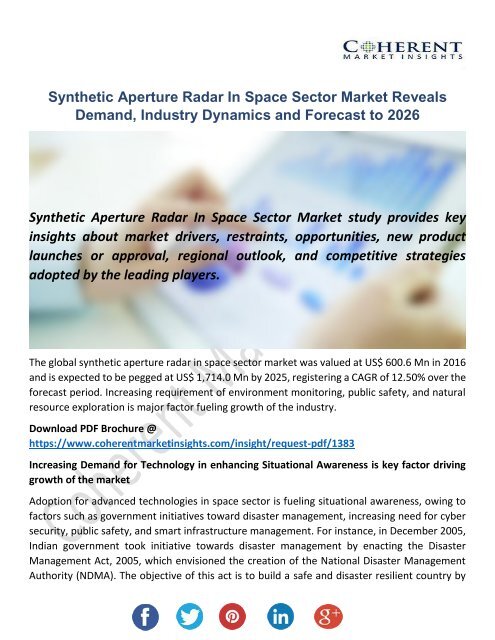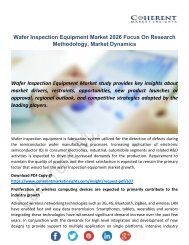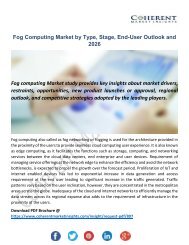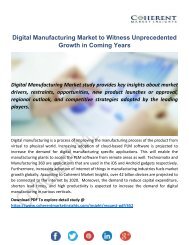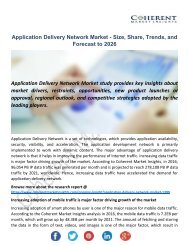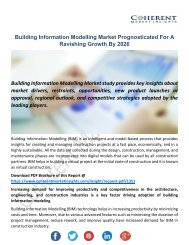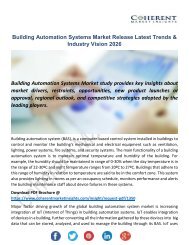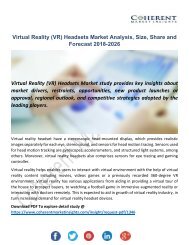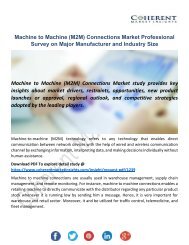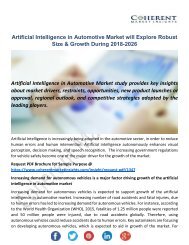Synthetic Aperture Radar In Space Sector Market
You also want an ePaper? Increase the reach of your titles
YUMPU automatically turns print PDFs into web optimized ePapers that Google loves.
<strong>Synthetic</strong> <strong>Aperture</strong> <strong>Radar</strong> <strong>In</strong> <strong>Space</strong> <strong>Sector</strong> <strong>Market</strong> Reveals<br />
Demand, <strong>In</strong>dustry Dynamics and Forecast to 2026<br />
<strong>Synthetic</strong> <strong>Aperture</strong> <strong>Radar</strong> <strong>In</strong> <strong>Space</strong> <strong>Sector</strong> <strong>Market</strong> study provides key<br />
insights about market drivers, restraints, opportunities, new product<br />
launches or approval, regional outlook, and competitive strategies<br />
adopted by the leading players.<br />
The global synthetic aperture radar in space sector market was valued at US$ 600.6 Mn in 2016<br />
and is expected to be pegged at US$ 1,714.0 Mn by 2025, registering a CAGR of 12.50% over the<br />
forecast period. <strong>In</strong>creasing requirement of environment monitoring, public safety, and natural<br />
resource exploration is major factor fueling growth of the industry.<br />
Download PDF Brochure @<br />
https://www.coherentmarketinsights.com/insight/request-pdf/1383<br />
<strong>In</strong>creasing Demand for Technology in enhancing Situational Awareness is key factor driving<br />
growth of the market<br />
Adoption for advanced technologies in space sector is fueling situational awareness, owing to<br />
factors such as government initiatives toward disaster management, increasing need for cyber<br />
security, public safety, and smart infrastructure management. For instance, in December 2005,<br />
<strong>In</strong>dian government took initiative towards disaster management by enacting the Disaster<br />
Management Act, 2005, which envisioned the creation of the National Disaster Management<br />
Authority (NDMA). The objective of this act is to build a safe and disaster resilient country by
developing a holistic, proactive, multi-disaster oriented and technology driven strategy through<br />
a culture of prevention, mitigation, preparedness, and response.<br />
Situation awareness is a model of decision making by observing, understanding, and forecasting<br />
scenarios. The arena of situation awareness consist of various products, components, and<br />
technologies to improve the perception of environmental factors within a specific space and<br />
time. Also, it aims in providing information associated with the location of critical assets, along<br />
with the state, location, and status of potential threats facing such assets. The key solutions<br />
available in the situation awareness systems include human-machine interface (HMI), physical<br />
security information management, fire and flood alarm systems, and access control. These<br />
solutions have potential application in disaster response, bio-surveillance, smart infrastructure<br />
management, and environmental impact tracing.<br />
High Development Cost of SAR due to Frequent Customization is the key factor expected to<br />
restrain growth of the market<br />
<strong>Synthetic</strong> <strong>Aperture</strong> <strong>Radar</strong> (SAR) systems are very important for the Earth Observation (EO)<br />
business. <strong>Synthetic</strong> aperture radar satellites system are typically more expensive to develop,<br />
and despite distinct advantages, the images are more complex, raising processing costs.<br />
Conventional synthetic aperture radars can balance tens of thousands of pounds and as large as<br />
a school bus. This are additionally responsible for providing significant capabilities for remote<br />
sensing, communication and science, but this costs hundreds of millions of dollars per satellite<br />
and may require years to build and launch. Owing to this huge investment required to construct,<br />
promotion and operation is expected to restraint the growth of the global synthetic aperture<br />
radar market during forecast period.<br />
Browse Complete Report @<br />
https://www.coherentmarketinsights.com/market-insight/synthetic-aperture-radar-in-space-sector-market-1383<br />
Single-frequency band segment dominated the market in 2016 and expected to retain its<br />
dominance during the forecast period<br />
Among the frequency band segment, single-frequency band accounted for the largest share of<br />
84.73% in the global SAR in space sector market in 2016. This growth is attributed to the growing<br />
requirement of the data generated by SARs for various defense, research, and commercial<br />
applications, including natural resource exploration and tracking ship movements in areas with<br />
bad weather conditions. According to Coherent <strong>Market</strong> <strong>In</strong>sights analysis, ongoing marine trade<br />
relations between Canada and North of Russia are highly prone to extreme weather conditions
and icebergs, which in turn propels demand for technologies ensuring safety of the ships and<br />
commodities necessitating the requirement of SARs.<br />
Defense application accounted for largest share in global SAR in space sector market in 2016<br />
Among application segment defense application is expected to witness a CAGR of 11.43% over<br />
the forecast period. This growth is attributed to the growing requirement of the data generated<br />
by SARs for various defense applications that include surveillance, reconnaissance, and<br />
environmental monitoring in areas with bad weather conditions.<br />
North America accounted for the largest market share in 2016<br />
On the basis of geography, global SAR in space sector market is segmented into North America,<br />
Europe, Asia Pacific, Middle East, and Africa. The market in North America accounted largest<br />
share in global SAR market for space sector application. The North America SAR market in <strong>Space</strong><br />
<strong>Sector</strong> was valued at about US$ 246.3 million in 2016. The U.S. and Canada are the major<br />
economies driving the market of SAR in space sector in North America region, prominently<br />
owing to the growing number of SAR constellation deployments in space. Chief instances of<br />
ongoing developments in this industry include the Capella (U.S.), OptiSAR (Canada), <strong>Radar</strong>sat<br />
(Canada), and SMAP (U.S.) projects. Furthermore, requirement of SAR imagery in commercial<br />
application for environmental monitoring specifically to monitor the ships and sea trade in<br />
North Atlantic Ocean and parts of Arctic Ocean are expected to provide key growth<br />
opportunities to the SAR in space sector market.<br />
Key companies<br />
Major players operating in the global synthetic aperture radar in space sector market include<br />
Airbus SE, Lockheed Martin Corporation, Israel Aerospace <strong>In</strong>dustries, Thales Group, Northrop<br />
Grumman Corporation, MDA <strong>In</strong>formation Systems, Raytheon Company, Harris Corporation, and<br />
BAE Systems.<br />
Get Discount on this Report @<br />
https://www.coherentmarketinsights.com/insight/request-discount/1383
About Coherent <strong>Market</strong> <strong>In</strong>sights:<br />
Coherent <strong>Market</strong> <strong>In</strong>sights is a prominent market research and consulting firm offering actionready<br />
syndicated research reports, custom market analysis, consulting services, and competitive<br />
analysis through various recommendations related to emerging market trends, technologies,<br />
and potential absolute dollar opportunity.<br />
Contact Us:<br />
Mr. Shah<br />
Coherent <strong>Market</strong> <strong>In</strong>sights<br />
1001 4th Ave,<br />
#3200<br />
Seattle, WA 98154<br />
Tel: +1-206-701-6702<br />
Email: sales@coherentmarketinsights.com


